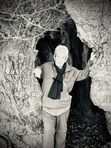The Icefield

[Photo is mine.]
There are lives that are erring and aimless,
And deaths that just hang by a hair…
~~Robert Service “The Spell of the Yukon”
It’s been a long time since I used a quote by the poet Robert Service. It’s been even longer since I thought about sitting on a ledge, alone, on the margin of the Taku Glacier, in the middle of the Juneau Icefield, about thirty-five miles from the nearest doctor, and thinking one thought:
What the hell have I gotten myself into?
Me, a sixteen year old from Owego, not yet a senior in high school, sat on that ledge and felt fear, real smack-in-your-face fear. Truthfully, I was not totally alone. But the geologist I was with was out of sight, doing whatever geologists do when they chip rock samples and check compass bearings and write things in little yellow notebooks. But the fear I felt that day has etched itself into my memory. I will never forget how helpless and fragile I felt sitting there and waiting for my partner to be finished.
At sixteen, I was the youngest assistant to be accepted by the Juneau Icefield Research Program. My brother, Chris, who was doing research for his MS and later a PhD, had convinced the Director, Dr. Maynard Miller, that I was not going to do the teenage thing. I was there to serve as a field assistant, carry loads, sometimes cook, be helpful, stay out of way and refrain from whining. I did these things and more. But underneath my placid exterior, I was freaking terrified.
At first anyway. As the summer wore on, I gained confidence. I was less afraid but never unaware that one misstep could end badly.
I sat there looking out over the glacier and kept thinking: Be careful. Be aware of everything around you. One slip on the chunky glacier ice, at the edge of a crevasse…a person would last only minutes at the bottom of that crevasse.

[The intensely beautiful blue ice of a deep crevasse. Somewhere down in the deep dark almost black ice usually is a pool of melt-water. Photo source: Unknown.]
The year was 1964. I returned to Owego in late August and soon began my final year in high school.
Three years later, I was hired by the USGS to be a Geologic Field Assistant. I found myself back on the Juneau Icefield, at the same isolated camps, geologizing on the same nunataks. This time I was being paid to camp, hike, climb mountains and help the geologists.
It was a sweet summer job and I knew it.
But it wasn’t long before the same fears and anxieties returned. This time the game was more serious. Four of us, two assistants and two geologists were more isolated, further back from Juneau, often in places that few others had been.
It was a day in July, 1967, when me and the geologists walked into a situation that was at once, surreal, interesting, challenging and totally terrifying.
We were X-country skiing across a large snowy expanse of the LLewellyn Glacier engaged in a serious discussion of a heavy topic, like the attributes of Helium over Hydrogen in dirigibles. And then we stopped.
We were in a whiteout. A cloud had descended onto a snowfield. No horizon. Nothing to judge direction and scale. No sky, the ground was just the few meters around our skis. We were sightless with our eyes wide open and seeing white in every direction. It’s difficult to find the words to describe the level of disorientation. There was nothing to do except to continue skiing, making every effort to follow a week old snow mobile track that was hard to see even in the best of conditions.
I was the first one to spot it. There was a brown bear directly in our path. I judged it to be about ten meters away. We discussed a plan. Play dead? Freeze? Slowly turn around? Or…or move aggressively toward it, screaming and banging on our water cups? We chose to attack, fully aware that if anything went wrong, it could prove to be lethal. And not for the bear.
Ten seconds later we both stood feeling rather silly. What I had seen and believed to be a bear (I really believed that at the time), was a five gallon fuel can. That’s what whiteouts will do. No sense of scale. Nothing to compare one thing to another.
But a little later, as the fog began to thin, I slowed my pace. I did not want this unique experience to end. I was (forget my companion for a moment) alone with myself. No distractions. No objects to look at. Just me and the cloud-ground world I had inhabited for two hours.
I never experienced that feeling ever again.
And, somehow, in a City, an ocean voyage, walking a path through a forest, strolling a footpath across a field of rape in Dorset, I seek that time when Nature overwhelmed me, tested me, took me down a few pegs and left me in awe.
Which brings me back to Robert Service. His poems have delighted me since I first read The Cremation of Sam McGee. I read it to my children and I hope to read it to my grandson.
One day in the summer of 1966, I was sitting on my front porch. I was trying to memorize one of Service’s shorter pieces when I came across two lines that struck me somewhere near my heart.
I’ve decided that I would like these lines engraved on my headstone.
It’s the beauty that fills me with wonder,
It’s the silence that fills me with peace



